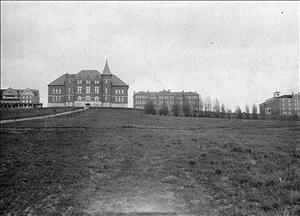In 1894, Professor W. J. Spillman arrives on the campus of the future Washington State University in Pullman, which is called the Agricultural College, Experiment Station and School of Science of the State of Washington. Spillman will become widely known for his advances in farming techniques, which will aid wheat farmers in the region.
Spillman's first bulletins treated the subjects of silos and silage, feeding wheat to hogs, and the Babcock milk test. Agricultural historian Wayne Rasmussen points out that these subjects, seemingly irrelevant to wheat farmers, were pointedly designed to help them.
Wheat farmers had recently suffered crops ruined by smut and unseasonable rains, as well as extremely low prices in 1892 and 1893. But Spillman's point was that smutty and wet wheat could be fed to hogs. His aim was to help farmers diversify, thereby lessening the risks of single-crop farming.
Spillman also sent out a circular asking wheat farmers what varieties they were growing. They responded that they were growing Little Club, Red Chaff, and Blue Stem. They requested the Experiment Station's help in providing a winter wheat. Spillman went on to develop several varieties of club wheat that were widely planted in the region.
Spillman left Washington state in 1902, moving on to the federal Department of Agriculture, where he became influential in developing the field of farm management, based partly on his experience in Eastern Washington.

